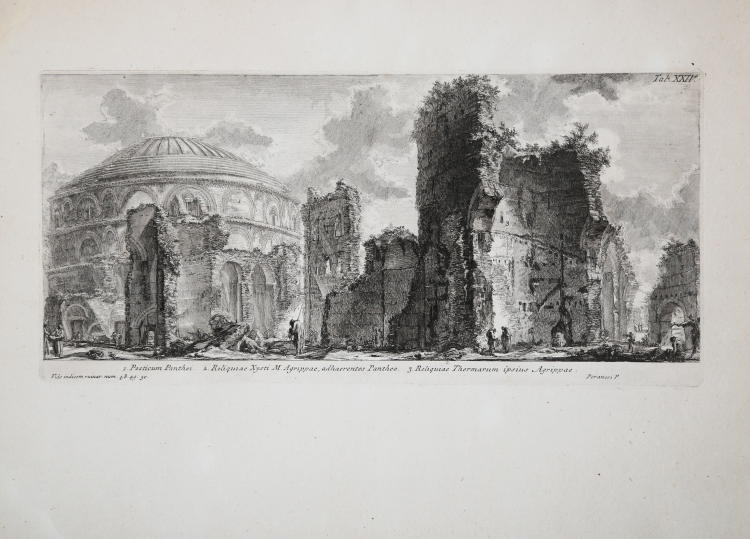



| Reference: | S45121 |
| Author | Giovan Battista PIRANESI |
| Year: | 1762 |
| Zone: | Pantheon |
| Printed: | Rome |
| Measures: | 435 x 210 mm |


| Reference: | S45121 |
| Author | Giovan Battista PIRANESI |
| Year: | 1762 |
| Zone: | Pantheon |
| Printed: | Rome |
| Measures: | 435 x 210 mm |
Etching, engraving and drypoint, circa 1762, signed in plate at the bottom.
Magnificent proof, printed on contemporary laid paper, in excellent condition.
Plate taken from Il Campo Marzio dell’Antica Roma opera di G.B. Piranesi socio della Real Società degli Antiquari di Londra.
Although published only in 1762, this fundamental work, which appears to be one of Piranesi's most complex, had already been announced by the artist in the Antichità Romane (1756) of which, according to Focillon, it can be considered as the fifth volume.
The story of the Campus Martius is intertwined with the friendship with the Scotsman Robert Adam, to whom the work is dedicated. Adam had arrived in Rome in 1755 and soon got to know Piranesi, perhaps through their mutual friend Charles-Louis Clerisseau, finding in their common archaeological passion the basis of a mutual esteem, which continued even after the architect's return to London. It was Adam himself who, during the reconnaissance of the remains of the monuments of the Campus Martius, suggested to Piranesi the idea of creating a map of the entire area, which initially was to be included in the Antiquities, and then ended up forming the basis of a much more ambitious project, giving birth to this important work. In the initial writings the author announces the purpose of this work, stating the will to trace the history of this vast area between the Tiber and the hills, trying to reconstruct the conformation and the face. He underlines the difficulty of this reconstruction work, since the ancient Campus Martius coincided with the most intensely populated and rebuilt area of the city from the Middle Ages to the present time, not hiding the margin of hypothetic inherent in the work. The result is that the reliability of the results remains very problematic, both for the pioneering archaeological research of the time, and for the visionary charge that leads the artist and the architect to overcome the limits of historical reality designing the past in function of the present, bringing the artistic genius to prevail by far on the archaeologist, giving sense and vigor to the whole work.
Bibliografia
H. Focillon, Giovan Battista Piranesi 1720-1778 (1918): n. 347; J. Wilton-Ely, Giovan Battista Piranesi, The complete etchings (1994): n. 480.
Giovan Battista PIRANESI (Mogliano Veneto 1720 - Roma 1778)
|
Italian etcher, engraver, designer, architect, archaeologist and theorist. He is considered one of the supreme exponents of topographical engraving, but his lifelong preoccupation with architecture was fundamental to his art. Although few of his architectural designs were executed, he had a seminal influence on European Neo-classicism through personal contacts with architects, patrons and visiting artists in Rome over the course of nearly four decades. His prolific output of etched plates, which combined remarkable flights of imagination with a strongly practical understanding of ancient Roman technology, fostered a new and lasting perception of antiquity. He was also a designer of festival structures and stage sets, interior decoration and furniture, as well as a restorer of antiquities. The interaction of this rare combination of activities led him to highly original concepts of design, which were advocated in a body of influential theoretical writings. The ultimate legacy of his unique vision of Roman civilization was an imaginative interpretation and re-creation of the past, which inspired writers and poets as much as artists and designers.
|
Giovan Battista PIRANESI (Mogliano Veneto 1720 - Roma 1778)
|
Italian etcher, engraver, designer, architect, archaeologist and theorist. He is considered one of the supreme exponents of topographical engraving, but his lifelong preoccupation with architecture was fundamental to his art. Although few of his architectural designs were executed, he had a seminal influence on European Neo-classicism through personal contacts with architects, patrons and visiting artists in Rome over the course of nearly four decades. His prolific output of etched plates, which combined remarkable flights of imagination with a strongly practical understanding of ancient Roman technology, fostered a new and lasting perception of antiquity. He was also a designer of festival structures and stage sets, interior decoration and furniture, as well as a restorer of antiquities. The interaction of this rare combination of activities led him to highly original concepts of design, which were advocated in a body of influential theoretical writings. The ultimate legacy of his unique vision of Roman civilization was an imaginative interpretation and re-creation of the past, which inspired writers and poets as much as artists and designers.
|